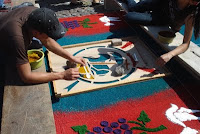First I had to find a good recipe. Since The Pioneer Woman is known for her good cooking, I looked for her recipe and found it here. (Follow the link for step-by-step instructions with pictures by PW.)
"1 quart Whole Milk
1 cup Vegetable Oil
1 cup Sugar
2 packages Active Dry Yeast, 0.25 Ounce Packets
8 cups (Plus 1 Cup Extra, Separated) All-purpose Flour
1 teaspoon (heaping) Baking Powder
1 teaspoon (scant) Baking Soda
1 Tablespoon (heaping) Salt
Plenty Of Melted Butter
2 cups Sugar
Generous Sprinkling Of Cinnamon"
Of course, my filling included this one, very Guatemalan ingredient:
coffee jelly.
PW also includes a frosting recipe with her cinnamon rolls that I did not use. The rolls tend to be sweet as they are, and the Mr. isn't fond of super-sugary treats. (That's why we get along so well.) Instead I just melted a little butter with brown sugar for the glaze.
When finished, I packed them into the only baking dish I had and baked them. PW recommends baking at 400 degrees 15-18 minutes, but here in the mountains of Guatemala City, I definitely needed to bake double that amount of time. It could also have something to do with the glass baking dish.
When they were finished, they were delicious! (Though really strange looking since they were all squished together and rose into interesting designs.) Not too sweet, but very tasty with a definite hint of coffee in the sweet insides.
There are also mango, strawberry, pineapple and other jellies made by this brand. Coffee seemed to be a good one for this filling, but I can think of a million other ways to use them.
Have you ever adapted a cinnamon roll recipe that you would like to share?








